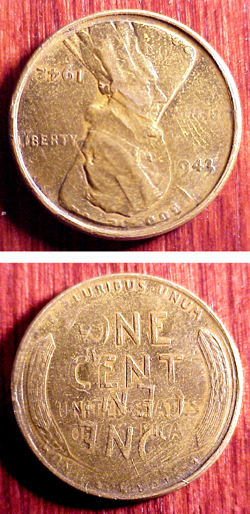|
"Making Cents"
The Signal
Saturday, December 16, 2006
| W |
Q: I have a 1942 cent showing evidence of 1943 date, as well. (See photos).
A: Anyone with a punch press can imprint anything on coins, and double dates are not that hard to make. This appears to be one of those fantasies. It has no numismatic value.
Q: I have a white metal 1942 cent. How can I tell if it is a mint variety?
A: First, check it with a magnet to see if it is the 1943 wartime metal. If it is magnetic, you have a very interesting variety. If not, there is a very remote possibility it was struck on a planchet meant for one of the various foreign coins made at the U.S. Mint during World War II. The most likely explanation, however, is that someone has plated a 1942 cent with a white metal zinc, chrome or silver. Show it to a few coin dealers and get a more exact opinion.
Q: I have what looks like an Indian head cent, but itıs a tiny bit larger than a regular cent and has the name and address of a coin dealer on the back. What is it?
A: In the 1960s, a private West Coast die maker called The Patrick Mint made small store cards similar in style to the better known Civil War store cards for use as business cards for coin dealers. I even had some made. The Indian head design is close to the real Indian head cent and similar to the Civil War store cards with that obverse. Other obverse designs include the Statue of Liberty and the Liberty Bell. I have seen some for sale recently at 25 cents each. Several hundred different types were made.
Q: I have a bracelet made with 10 British gold sovereigns that my father bought during World War I in Turkey. What value can you tell me?
A: Chances are, the gold coins are counterfeits made of gold. In many cases, gold counterfeits were made in the Middle East of gold less than .916 fine (22-carat) and sold for jewelry. The bracelet is worth whatever dealers are paying for 18-carat gold. Even if the coins were genuine, they have solder on the rims and thus are worth only their gold content.
Q: I have a crisp, never-used $100 bill with red seal and red serial numbers. Is this an error or a rare variety?
A: It is neither. A short run of United States notes was printed some 40 years ago, and most were never put into circulation. I checked with a local dealer and he has some for sale for $125.
Q: If the new dollar coin is to make its way into our lives, does the Bureau of Engraving and Printing have to stop making $1 bills?
A: You are correct. More than half the BEPıs output is the $1 bill, and to cut out that part of its production would reduce the BEPıs operating staff and budget by 50 percent or more. I guess the BEP strongly resists ending the $1 bill and lobbies for its continued use. Thus, the $1 coin has little or no chance to succeed. Countries such as Canada, Great Britain and Australia stopped making $1 (and 1 pound) bills years ago, and their dollar or pound coins are a normal part of daily commerce. Most of our $1 coins made from 1979 to 2004 are stashed away in the Treasury vaults, since banks and retail stores are not asking for them.
Dr. Sol Taylor of Sherman Oaks is president of the Society of Lincoln Cent Collectors and author of The Standard Guide to the Lincoln Cent. Click here for ordering information.
©2006, THE SIGNAL · ALL RIGHTS RESERVED.

![[Most Recent Quotes from www.kitco.com]](http://www.kitconet.com/images/quotes_special.gif)

